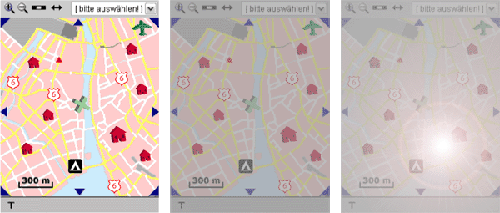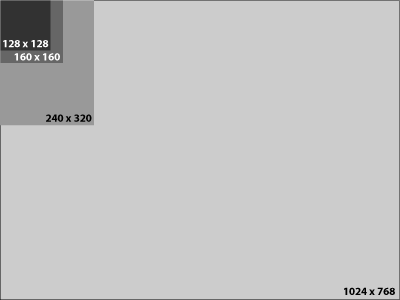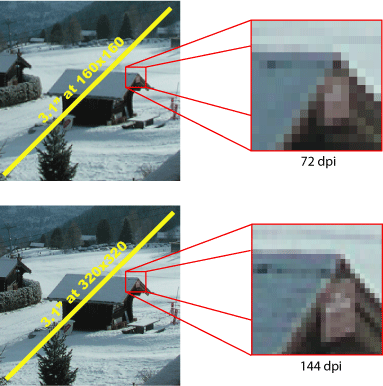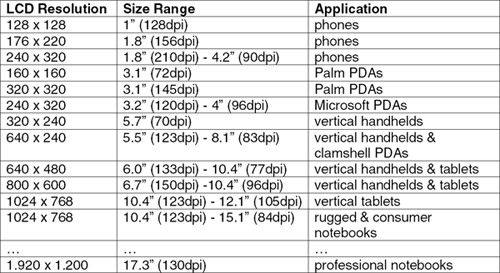1.1.3. Display Facts
Display Technologies
Colour ![]() LCD (Liquid Cristal Display) displays
have somewhat become standard in mobile phones and
PDAs. But the different LCDs differ very much in colours, size and
resolution. The display contrast and brightness as well as the size
and the sharpness depend on the technology used for the display. There
are two basic technologies used today in colour LCDs: active-matrix,
commonly called
LCD (Liquid Cristal Display) displays
have somewhat become standard in mobile phones and
PDAs. But the different LCDs differ very much in colours, size and
resolution. The display contrast and brightness as well as the size
and the sharpness depend on the technology used for the display. There
are two basic technologies used today in colour LCDs: active-matrix,
commonly called ![]() TFT, and passive-matrix,
commonly called
TFT, and passive-matrix,
commonly called ![]() STN.
Comparing the two technologies, TFT has a higher contrast (it therefore
seems brighter and easier to see), has more saturated colors, can be
viewed at wider angles, and is generally more expensive than STN. LCD
manufacturers are in general moving away from STN and towards TFT.
But TFT LCDs are usually consuming more energy which is influencing
the device runtime.
STN.
Comparing the two technologies, TFT has a higher contrast (it therefore
seems brighter and easier to see), has more saturated colors, can be
viewed at wider angles, and is generally more expensive than STN. LCD
manufacturers are in general moving away from STN and towards TFT.
But TFT LCDs are usually consuming more energy which is influencing
the device runtime.
The display brightness and contrast can also be influenced by the display reflectivity in combination with sunlight. When using such a device outdoors colours and contours can be sometimes very hard to see because of bright sunlight and/or reflections in the display.
 Map in a PDA display at normal light, outdoors and with reflections
Map in a PDA display at normal light, outdoors and with reflectionsDisplay Resolution and Size
In the image below you see some common display resolutions of LCD displays. The largest one with 1024 x 768 pixels is the resolution of a standard notebook or home computer. Thus a common PDA display with 240 x 320 pixels can show only approx 1/8 of the amount of information a normal computer screen can show.
 Different Screen Size Proportions
Different Screen Size ProportionsResolution and size are closely related -- in general, the more pixels (dots) there are in an LCD, the larger is it's resolution. Actually the number of dots per inch (dpi) in LCDs shipping in products today ranges from a low of 70 to more than 200. Most current LCDs fall in the range of 90 to 150 dpi. Pixels are dots of RGB-colored light that make up all computer images. The more pixels that can be displayed on a screen, the greater detail and the more information that can be displayed on the screen at one time and the image looks more sharp. The resolution is described by the number of columns and rows of pixels that can be displayed. For example, a display capable of displaying 128 x 160 is able to display 128 columns by 160 rows of information.
 Relation between display size and resolution. Typical Palm display with 160x160
() or 320x320 pixels.
Relation between display size and resolution. Typical Palm display with 160x160
() or 320x320 pixels.The two examples above show the typical screen size of a Palm PDA with two different resolutions. The inexpensive Palm PDAs are only equipped with a 160x160 pixel display while the better screens have a 320x320 pixel display. The size of the displays however is 3.1" for both devices. Thus the better display can show more information at the same size an is much sharper.
In the following table typical display resolutions and sizes for mobile devices like phones, PDAs and notebooks are listed:
 Typical display sizes and resolutions
Typical display sizes and resolutions